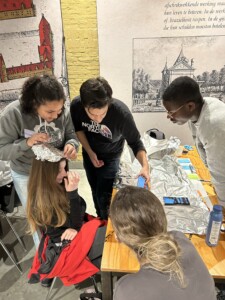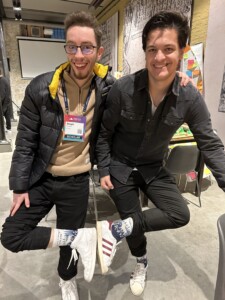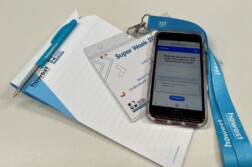YES-week (Youth Exchange School) took its place during the first week of December 2023. NHL Stenden University of Applied Sciences campus and Blokhuispoort (“The Jail”) in Leeuwarden, Netherlands, gathered students “behind the bars” to solve wicked problems related to future mobility and living. Our customer was related to Vital Regions of NHL Stenden, and the local university was plunged into innovating solutions for local problems. During this week we had students from all over the RUN-EU network, from diverse backgrounds and countries. The name of the game, or more like as a method we used, was design thinking and its variety of tools.
The characteristics of DBE
Design-based education (DBE) is an educational concept and in NHL Stenden it consists of five facets: Design Thinking is a method that fits in designing solutions for challenges. Via prototyping, we can also explore what solution might work. Multidisciplinary environment offers diversity in thinking because we invite students from different degree programs, researchers, industry, and teachers to collaborate. Sustainable education plays an important part, as it offers one learning process for social issues. Our international and intercultural environments offer diversity alongside having an eye for international aspects. Personal leadership as a fifth facet prepares students to become aware of their own identity, alongside many other responsibilities in life. Our YES-week was a combination of all these skills’ building blocks.

Student experiences of DBE
Our RUN-EU student Niklas Kübler from the Vorarlberg University of Applied Sciences, Austria, was one of the participants during this week. His experience was mostly related to the design thinking process itself. Even though Niklas is experienced at many levels as a student, this method was new to him. As the week progressed, his understanding of the method and tools grew. He found out that you can use design thinking on many occasions, many ways. The week itself was very interesting, the new way of working and a diverse group from different RUN-EU partners made the experience memorable. “Oh, I would definitely apply again, if that would be possible! Great experience, I learned so much!”
Sari Mansala, student of Häme University of Applied Sciences from Finland, also found out the benefits of the week. Of course, meeting new people is “the thing” to do, getting new friends as well, but she was also interested in the content of the week. It was very clear how design thinking as a process goes into practice. She liked the fact that we used one whole day to one element of design thinking. It gave her a chance to dive into every step and learn the process. The major outcomes were related to communication in a diverse group. “How to include individuals’ thoughts and ideas so that every person is heard and understood, and we are on the same page?” It’s not easy for everybody to switch their native language to English, trying to figure out, how to live in another country for a while and see, how daily aspects are functioning. But this is one of the topics we want to highlight and encourage as RUN-EU’ers: apply if you are interested in making a short dive into new culture and hab
its. “Unfortunately, I graduate soon, so I can’t apply anymore to these programs. But I can highly recommend to students after me take this chance, especially if you want to learn to do something differently!”
Alessandra Belmonte Silva is a Brazilian student, who studies in Polytechnic at Leiria. “My background is from military school, where everything was strict and in order. You needed to do exactly what was told. But here I can use my creativity freely and it has been so different and awesome. Design thinking is not just a method, it’s so much more. I can almost touch the diversity!” Quite often we hear the same feedback. The other is that after weeks like these, students are exhausted. But that is a normal part of the process. And I can tell you that we teachers are tired too, but in a good way. The process is familiar to us, so we don’t need to learn it anymore. But every group is different and because we are working with real challenges in collaboration with industries, people, and life outside of design thinking, we need to be ready for something to happen all the time. And it usually happens! I wouldn’t change my job: co-organizing events like this is my salt and pepper. For the students we want to create unique opportunities, but still from everyday life, because we want to keep challenges realistic.
Even though we are working with authentic working life challenges, we want to teach future and regenerative thinking by using our company cases. Sometimes futuristic thinking might feel that we are not concentrating on the topic. But we didn’t have mobile phones, internet, or laptops 50 years ago. Nowadays these elements are normal to us, and current kids and teens are digital natives. But without the future and outside-of-the-box mindset we won’t go further in development. Combining these big elements makes studies interesting.
Author
Sanna-Maaria Siintoharju, HAMK Design Factory





